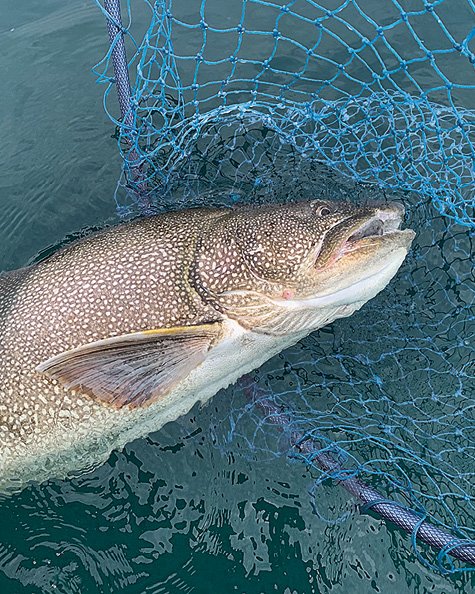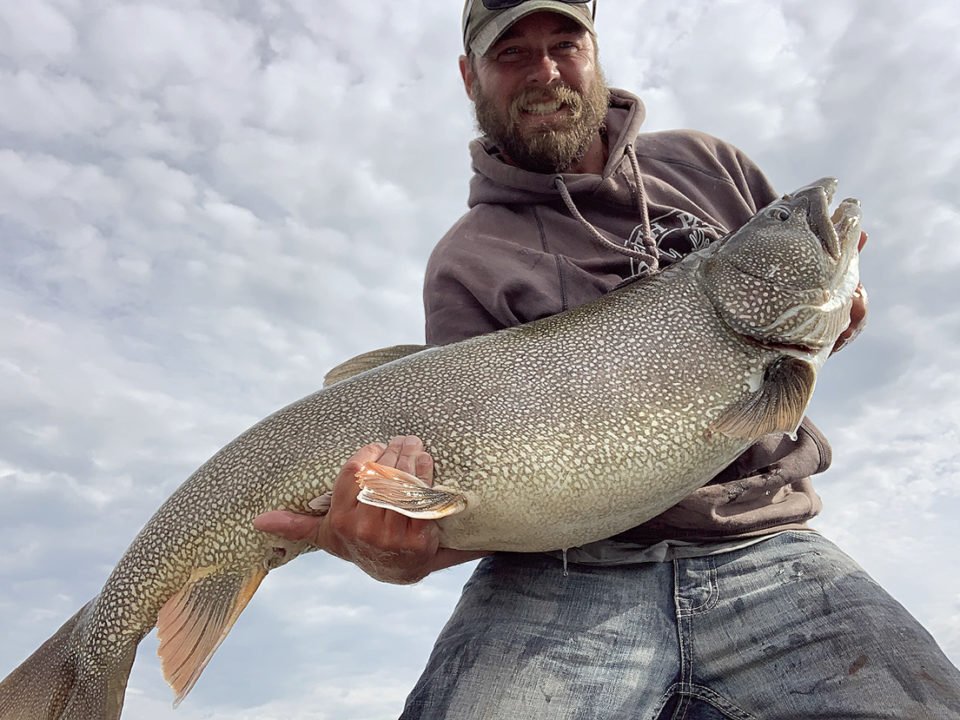I have fished Lake Superior long enough to know that some days you’re a hero and some days you’re a zero.
I love fishing that big pond, with the clearest water you can imagine stretching farther than you can see. It almost seems too surreal to be true. Sitting in a boat on that lake—even a large one—makes you feel small and insignificant. And it’s the only place in the world where if I’m not catching fish, I don’t mind. I get so mesmerized with the water that everything else is just a bonus.
It was the Monday after Fourth of July weekend. Friends and tourists had gone home after one of the busiest weekends of the summer. On that morning, as I launched by myself out of Two Harbors, I felt lonelier out on the water than I ever have.
A few days earlier, on a morning when the big lake looked like a mirror, I’d witnessed coho salmon dappling the calm surface as they fed on mayflies. Although Superior’s cohos are small, I can’t think of another fish I’d rather eat and I hoped to invite one home to dinner. Actually, I hoped to catch one on a fly rod from my boat—something I’d be willing to bet few people have ever done. But although the lake was calm, there was just enough ripple to make it hard to see feeding fish. I soon scrapped the fly rod. I trolled for salmon for an hour, but my efforts were futile. I decided to switch to lake trout along a rocky reef in about 50 feet of water. The surface temp was 62 degrees F, which is a little warm for lake trout. I decided to “bounce bottom,” which means keeping your downrigger ball right near the bottom and trailing a lure behind it.
I was happy and maybe even a little surprised when just minutes after switching gears I saw something that makes my heart race: one of my trolling rods was bouncing. Fish on!
A minute or two later, I netted a nice “eater-sized” lake trout. Into the livewell it went for supper, but not before I snapped a selfie with it and texted the photo to my girlfriend, Amanda, who couldn’t fish because she was working. People say that sometimes I’m a jerk, but they’re wrong…I’m always a jerk!
I swung around for another pass and, once again, my rod bounced in the holder. It was another lake trout, but this guy was tiny. After landing him, I put the boat in neutral and placed him back in the water. He shot right back down to the bottom.
On my third pass, I hooked my third lake trout of the morning. It was the same size as the first and would have been a good keeper, but one trout was plenty for supper, so I let that one go, too. The limit on lake trout is three and it’s not every day I limit out, especially when I’m fishing by myself with the legally allotted two lines. When you’re fishing with other anglers, you can put out more lines, which lets you run different depths, colors and even lure types, so it’s easier to figure out what the fish want. Fishing solo stacks the deck against you. With just two lines, I feel like I’m throwing two darts at an enormous dartboard.
Of course, I had to text Amanda pictures of all the fish. It had been an exceptional morning. The time stamp on the photo of the third fish indicated I’d caught three lakers by 7:51 a.m. If I’d have kept the last two, I’d be pulling lines and heading back to the landing before 8 a.m.! But it was a good thing I let them go…
I saw my downrigger rod stand up on the next pass. Let me explain the physics. The downrigger consists of a large reel with a cable attached to a heavy lead weight. You run your fishing line behind the boat and attach it to the downrigger cable with a release. The heavy weight takes your line deep into the water. When a fish bites, a snap of the fishing rod releases your fishing line from the downrigger cable, allowing you to fight just the fish; not the downrigger weight, which on my boat weighs 8 pounds. Downrigger rods are kind of noodly. Once the rod is in the holder, you crank the fishing reel tight, which puts a big bow in the rod. If the line isn’t taught, you won’t see the bounce of a fish; there will be too much slack.
But in this case, the rod stood up. That means the downrigger weight hit the bottom. Now, instead of being weighted down by the downrigger weight, the tension was off the line and the rod stood erect. Problem is, when you’re fishing over a rocky bottom, you can easily become snagged. When the weight snags a rock, your boat essentially becomes anchored, which is dangerous. Also, you can break your downrigger and lose the lead weight. Nothing good can happen.
So, I sprang from my seat and furiously cranked up the weight a few feet. Then I grabbed the fishing rod and gave it a yank to release the line from the downrigger, which actually was unnecessary, but I wanted to make sure nothing was snagged. The second the line was released, my spoon started planing to the surface. I was sure there was nothing there…but seconds later, I felt immense weight. I was snagged on the bottom; or so I thought. But there was “give” to this snag. A snagged rock doesn’t move. But a tree branch does. That’s what I was thinking, right up until I felt a strong headshake. No, this was a fish, and a big one!

I was immediately amazed at the power of this fish. Lake trout aren’t known as strong fighters—at least not average-sized lake trout. Usually, they just come to the surface. But not this fish. It was intent on staying where it was: on the bottom.
The boat was in gear, which kept tension on the fish, so I cranked my downrigger weight up so I wouldn’t snag it as I battled the fish. Then I put the boat in neutral. The fish was just too strong and the boat’s forward momentum put unnecessary torque on the rod and line.
I tried to reel in the fish, but it had other ideas. I couldn’t gain line. All I could do was loosen the drag and hang on as the monstrous fish bulldogged its way back to the bottom. After a few minutes, it occurred to me that I should film the whole ordeal, so I propped up my phone against my tackle box.
The fish remained in total control. I don’t think I’ve ever battled a lake trout for more than a couple minutes. Even a 20-pounder I’d caught the year before tired quickly. I knew whatever I had latched onto was special.
Using the video as a reference, I’d say it took 11 minutes of constant pressure before the fish rose off the bottom. Fifty feet of water is shallow by Lake Superior standards, and with visibility close to 20 feet, I was astounded I couldn’t see the fish, but finally it relented. Once I began gaining line, the fish seemed to be giving up and for the first time, the needle of control swung in my favor. Far down below a silver streak appeared as I finally glimpsed the fish. Seconds later, it was at the surface.
Then came a crazy decision: do I net it immediately and just land it, or do I film it and risk losing it? I really wanted to land this fish. I needed a picture or no one would believe me! But I decided to try to film it briefly at the surface. I got a few seconds of footage, then netted the pig of a fish.
I was absolutely overwhelmed by the size of the laker. Its fins were as large as my hands. The fish taped out at 44 inches and had a 26-inch girth. A weight calculator estimated the fish weighed 37 pounds. The state record is a 43.5 pounder, caught back in 1955 off of Hovland. By fall, when my fish’s eggs were fully developed, it could have been a record. Who knows?
The choice of what to do with the giant was a no-brainer. Lake trout don’t mature until they are about 6 or 7 years old. Without taking samples, it’s impossible to say how old this trout was, but it could have been 30 to 50 years old. There was no way I could kill something like that. Plus, such a large fish would produce a lot of eggs. After snapping a few selfies, I put the beast back in the lake.
I tried my best to hold the fish horizontally in the water, but it’s hard to control a fish that long and heavy. The head sank and I struggled to maintain my grip around the base of the tail.
The exhausted fish sat in the water. I wondered if she would release ok. The water was only 50 feet deep, and lake trout can adjust to changes in depth much better than other species. And although the surface water was on the warm side, the fish stayed on the bottom for most of the fight where it was obviously cooler. I vowed to stay with the fish as long as it took for it to revive.
It took a minute or two, but eventually the exhausted fish regained its strength. The once-docile fish now began to thrash its tail, telling me she was ready to go. I held on for a couple thrashes, then released my grip and watched the giant fish swim down and out of sight.
The outdoors is full of magic. Watching a sunrise over Lake Superior, seeing the aurora borealis dance across the northern sky or sitting quietly as a bull moose dips its head for a drink of water on a lily pad pond can take your breath away. I’d crossed paths with a fish that may well have been even older than I am. It’s satisfying to know that fish is still out there to perpetuate its species and perhaps thrill another angler.






